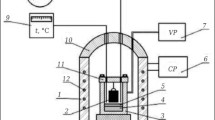Abstract
This paper describes the long-range work initiated by The British Aluminium Co. (and developed in association with the Kaiser Aluminum & Chemical Corp.) on the application of the carbides and borides of the transition elements to cathode construction in aluminum reduction cells. Titanium and zirconium borides and carbide/ boride mixtures are particularly suitable for this purpose, and the project has required the preparation and fabrication of these materials in the form of massive pieces of a closely controlled quality. It has been found possible to produce these at an acceptable cost. By the use of these materials the cathode voltage drop can be considerably reduced, and various new types of cell structure become feasible. The cell lining, for example, can be made electrically neutral; under these conditions flux absorption is markedly less than in orthodox cells. A further advantage is that magnetic fields can be virtually eliminated. Some results on full production cells presently in operation are reported.
Access this chapter
Tax calculation will be finalised at checkout
Purchases are for personal use only
Preview
Unable to display preview. Download preview PDF.
Similar content being viewed by others
References
Pearson, T. G., The Chemical Background of the Aluminium Industry, Royal Inst. Chem. Lectures, Monographs and Reports, No. 3, London, 1950.
Lewis, R. A., Chem. Eng. Prog., 56, 78 (1960).
Seager, G. C., this Vol., p. 131.
Brit. Pats. 784,605, 784,096, 802,471, 802,905.
British Pat. 804,242.
Blum, A., and J. H. Wieliczko, Planseeber. Pulvermet, 9, No. 1/2, 77 (1961).
Maedonald, N. F., and C. E. Ransley, Powder Met., 3, 172 (1959).
British Pat. 825,443.
French Pat. 1,227,482.
Materials Survey, Aluminum, Business and Defense Services Administration, U. S. Dept. Comm., Washington, 1956.
Author information
Authors and Affiliations
Editor information
Editors and Affiliations
Rights and permissions
Copyright information
© 2016 The Minerals, Metals & Materials Society
About this chapter
Cite this chapter
Ransley, C.E. (2016). The Application of the Refractory Carbides and Borides to Aluminum Reduction Cells. In: Tomsett, A., Johnson, J. (eds) Essential Readings in Light Metals. Springer, Cham. https://doi.org/10.1007/978-3-319-48200-2_151
Download citation
DOI: https://doi.org/10.1007/978-3-319-48200-2_151
Publisher Name: Springer, Cham
Print ISBN: 978-3-319-48577-5
Online ISBN: 978-3-319-48200-2
eBook Packages: Chemistry and Materials ScienceChemistry and Material Science (R0)



